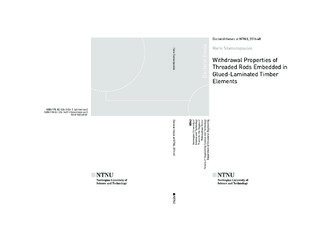| dc.contributor.advisor | Malo, Kjell Arne | |
| dc.contributor.author | Stamatopoulos, Haris | |
| dc.date.accessioned | 2016-03-17T10:03:04Z | |
| dc.date.available | 2016-03-17T10:03:04Z | |
| dc.date.issued | 2016 | |
| dc.identifier.isbn | 978-82-326-1437-0 | |
| dc.identifier.issn | 1503-8181 | |
| dc.identifier.uri | http://hdl.handle.net/11250/2382376 | |
| dc.description.abstract | The competitiveness of timber structures is largely governed by the design and effectiveness of the connections. Connections with long axially loaded self-tapping screws or threaded rods embedded with an inclination to the grain direction can be an alternative to connections with dowel-type fasteners or glued-in rods. Self-tapping screws and especially threaded rods with large diameters feature high withdrawal capacity and stiffness. This ability makes them suitable as fasteners in connections in order to realize stiff and strong joints.
Eurocode 5 does not provide rules for the estimation of the withdrawal stiffness of axially loaded fasteners, which is necessary for the determination of the stiffness of connections. Some rules can be found in technical approvals; however they are only valid for the instantaneous withdrawal stiffness under service load of self-tapping screws with small diameters. Consequently, there is a complete lack of guidelines for the estimation of the withdrawal stiffness of threaded rods with larger diameters. Moreover, Eurocode 5 imposes a limitation to the angle between the rod-axis and the grain direction (α ≥ 30°) without taking into account that splitting may be prevented by reinforcement. The lack of knowledge of proper design, documentation of mechanical behaviour, design guidelines and design codes for threaded rods are barriers for the development of timber connections with these fasteners.
The withdrawal properties (capacity and stiffness) of axially loaded threaded rods were investigated in the present thesis by use of experimental, analytical and numerical methods. An overview of the background information and research on withdrawal of screws and threaded rods is presented in Part I of the present thesis. Part II consists of 4 appended papers where the findings of this Ph.D. project are presented. Part III consists of 3 appendices where some analytical remarks together with the detailed experimental and numerical results are presented.
The review on the existing approaches and experimental results have shown that, up-to-date, most research effort has been devoted on the determination of the withdrawal strength of self-tapping screws with diameters up to 12-14 mm. On the contrary, available research results for threaded rods with larger diameters are sparse and the vast majority of these results are limited to relatively stocky rods embedded either parallel or perpendicular to the grain. Therefore, the effect of the rod-to-grain angle and the embedment length on the withdrawal properties remains unknown.
The parameters of the experimental investigation were the rod-to-grain angle (α = 0-90°) and the embedment length (l = 100-600 mm). Specimens with single rods and with a pair of rods (arranged in a row perpendicular to the plane of the grain) embedded in glued-laminated timber (abbr. glulam) elements were tested. Moreover, an analytical approach based on Volkersen theory and a bi-linear constitutive relationship was used for the estimation of the elastic and post-elastic withdrawal properties. Finally, Finite Element (abbr. FE) simulations were performed to estimate the instantaneous withdrawal stiffness (under service load) and the elastic distributions of stresses and displacements.
According to experimental observation, the specimens exhibited high withdrawal capacity and stiffness (without initial soft response). Based on the experimental results, the necessary input parameters for the analytical method were quantified. In particular, simple expressions for the mean and 5%-percentile withdrawal strength, the shear stiffness and the brittleness were developed. In general, the analytical estimations and the experimental results were in good agreement. Numerical estimations overestimated stiffness especially for small angles and short embedment lengths; however this overestimation was smaller in the case of longer rods. Finally, the experimental results from tests with pairs of rods showed that the effectiveness per each rod was quite high, despite the fact that rods were placed with small edge distances and spacings. | nb_NO |
| dc.language.iso | eng | nb_NO |
| dc.publisher | NTNU | nb_NO |
| dc.relation.ispartofseries | Doctoral thesis at NTNU;2016:48 | |
| dc.relation.haspart | Paper 1:
Stamatopoulos, Haris; Malo, Kjell Arne.
Withdrawal stiffness of threaded rods embedded in timber elements.
Is not included due to copyright | |
| dc.relation.haspart | Paper 2:
Stamatopoulos, Haris; Malo, Kjell Arne.
Withdrawal capacity of threaded rods embedded in timber elements. Construction and Building Materials 2015 ;Volum 94. s. 387-397
<a href="http://dx.doi.org/ 10.1016/j.conbuildmat.2015.07.067" target="_blank"> http://dx.doi.org/ 10.1016/j.conbuildmat.2015.07.067</a>
This article is reprinted with kind permission from Elsevier, sciencedirect.com | |
| dc.relation.haspart | Paper 3:
Stamatopoulos, Haris; Malo, Kjell Arne.
Withdrawal of pairs of threaded rods with small edge distances and spacings.
Is not included due to copyright. | |
| dc.relation.haspart | Paper 4:
Stamatopoulos, Haris; Malo, Kjell Arne.
Characteristic withdrawal capacity and stiffness of threaded rods. INTER - International Network on Timber Engineering Research 2015 s. 99-111 | |
| dc.subject | withdrawal strength, withdrawal capacity, withdrawal stiffness, threaded rods, timber, glulam, embedment length, rod-to-grain angle | nb_NO |
| dc.title | Withdrawal Properties of Threaded Rods Embedded in Glued-Laminated Timber Elements | nb_NO |
| dc.type | Doctoral thesis | nb_NO |
| dc.subject.nsi | VDP::Technology: 500::Building technology: 530::Construction technology: 533 | nb_NO |

